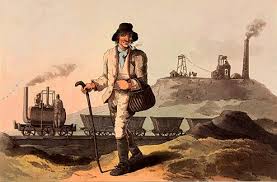“Social Effects of Industrialization” – Everything You Need to Know
Industrialization did more than transform economies—it reshaped societies, cultures, and individual lives. In this comprehensive post, we explore the Social Effects of Industrialization, delving into its definition, historical roots, and far-reaching impact on daily life. Whether you’re a student, educator, or curious reader, this guide will provide you with in-depth insights into how industrialization has redefined social structures, family dynamics, urban communities, and cultural norms.
Introduction: A Revolution Beyond Factories
Did you know that the industrial era not only revolutionized production but also altered the very fabric of society? During the 18th and 19th centuries, millions of people left rural life for rapidly growing urban centers, setting off profound changes in lifestyles, relationships, and community structures. In this article on the Social Effects of Industrialization, we will explore:
- A clear and thorough definition of the term.
- Historical context and key milestones that influenced social change.
- In-depth analysis of the impacts on family life, urbanization, education, and more.
- Real-world examples and case studies that illustrate these changes.
- Addressing common misconceptions and frequently asked questions.
- The modern relevance of industrialization’s social legacy.
Understanding these effects is essential—not only to grasp our past but also to comprehend how historical transformations continue to shape our society today.
What Are the Social Effects of Industrialization?
Defining the Concept
Social Effects of Industrialization refer to the wide-ranging changes in social structures, relationships, and cultural practices that emerged as a direct consequence of the industrial era. This phenomenon is characterized by several essential properties:
- Urbanization: A significant migration from rural areas to cities, leading to the growth of urban centers.
- Changing Family Dynamics: Shifts in traditional family roles as economic activities moved from the home to the factory.
- New Work and Labor Models: The rise of factory work, the emergence of wage labor, and the evolution of labor unions.
- Education and Skill Development: Increased emphasis on formal education and vocational training to meet the demands of industrialized economies.
- Cultural Transformation: The spread of new ideas, values, and social norms as communities adapted to rapid technological and economic change.
- Social Stratification and Mobility: The development of distinct social classes and new opportunities—and challenges—for social mobility.
By examining these characteristics, we can appreciate how industrialization reshaped everyday life and laid the groundwork for modern social systems.
Historical and Contextual Background
The Dawn of Industrial Society
Industrialization began in Great Britain in the late 18th century and soon spread to the rest of Europe, North America, and beyond. This era marked a turning point when handcrafted goods and agrarian lifestyles were replaced by mass production and mechanization. But its effects extended far beyond economic metrics—they touched every aspect of society.
Key Historical Milestones
The First Industrial Revolution (c. 1760–1840):
- Technological Innovations: The advent of steam power, mechanized textile production, and improved metallurgy initiated a production boom.
- Social Upheaval: Traditional agrarian lifestyles were disrupted as people moved to cities in search of work, leading to significant demographic shifts.
Urbanization and the Rise of the Factory System:
- Population Shifts: Rural areas saw declining populations as industrial jobs in urban centers attracted workers.
- Family Structure Changes: With work moving outside the home, traditional roles within families began to evolve.
The Second Industrial Revolution (c. 1870–1914):
- Technological Expansion: Innovations such as electricity, the internal combustion engine, and mass production further accelerated industrial growth.
- Social Reforms: Labor unions emerged, and social reforms began addressing the harsh conditions in urban factories.
Global Spread:
- As industrialization spread worldwide, its social effects were felt in diverse contexts—from the sprawling metropolises of America and Europe to emerging industrial centers in Asia and Latin America.
Notable Anecdotes and Events
- The Rise of Manchester: Often dubbed “Cottonopolis,” Manchester became a symbol of industrial might and social transformation in Britain. The city’s rapid growth led to both spectacular economic progress and challenging living conditions, including overcrowded housing and sanitation issues.
- Child Labor Debates: In many industrial centers, children worked long hours in hazardous conditions. This spurred public outcry and eventual reforms in labor laws, highlighting the social costs of industrial progress.
- The Labor Movement: Strikes and protests, such as the 1830 Swing Riots in England and the numerous labor strikes in the United States, underscored the struggle for workers’ rights, eventually leading to important reforms in labor standards and working conditions.
In-Depth Exploration of the Social Effects of Industrialization
To fully understand the Social Effects of Industrialization, we must explore the various dimensions through which society was transformed. Below, we break down these impacts into clear, digestible sections.
1. Urbanization: The Growth of Industrial Cities
a. The Migration from Rural to Urban Areas
One of the most dramatic social changes brought about by industrialization was the mass migration from the countryside to urban centers.
Population Explosion:
Cities like London, New York, and Berlin experienced unprecedented growth. For example, London’s population soared from 1 million in 1800 to over 6 million by the early 20th century.Formation of Urban Communities:
As rural dwellers congregated in cities, new forms of community life emerged. Neighborhoods developed distinct identities, and urban culture flourished with the rise of theaters, coffee houses, and public spaces.
b. Challenges and Opportunities of Urban Living
Urbanization brought with it both opportunities and significant challenges:
- Opportunities:
- Economic Growth: Increased job opportunities in factories, retail, and services.
- Cultural Exchange: Cities became melting pots of ideas, innovation, and diversity.
- Challenges:
- Overcrowding: Rapid urban growth often outpaced the development of adequate housing, leading to slums and congested living conditions.
- Sanitation and Public Health: Insufficient infrastructure resulted in poor sanitation and frequent outbreaks of diseases such as cholera and tuberculosis.
- Social Isolation: Despite the large populations, many urban residents experienced isolation in the impersonal environment of a sprawling metropolis.
2. Changing Family Structures and Gender Roles
a. The Erosion of Traditional Family Models
Industrialization fundamentally altered the way families functioned:
Work Outside the Home:
Prior to industrialization, families typically worked together on farms or in small-scale production at home. The shift to factory-based work separated home life from the workplace.Redefined Roles:
- Men as Breadwinners: Men increasingly took on the role of the primary wage earner, while women were often relegated to domestic duties.
- Women in the Workforce: In many urban centers, women and children entered the labor force, particularly in textiles and manufacturing. Although often underpaid, this shift contributed to early movements for gender equality and labor rights.
b. Impacts on Social Norms and Interpersonal Relationships
The transformation in family dynamics led to changes in broader social interactions:
Rise of the Nuclear Family:
With urban living, the extended family model became less common, giving rise to smaller, nuclear family units.Shift in Marriage Patterns:
Industrialization influenced the timing and nature of marriage. As individuals moved away from family farms, they often married later and based marital decisions on factors beyond economic necessity.Generational Tensions:
The rapid pace of change sometimes created tensions between generations, as older family members clung to traditional values while younger generations embraced new ideas and lifestyles.
3. Work, Labor, and the Birth of the Modern Workforce
a. The Transformation of Work Environments
The advent of factories and mechanized production methods brought about a radical change in how work was organized.
- Factory Life:
- Structured Work Hours: The rigid schedules of factory work replaced the more flexible rhythms of agrarian life.
- Division of Labor: Tasks were broken down into repetitive, specialized jobs, increasing efficiency but often reducing job satisfaction.
- Emergence of Wage Labor:
As people traded the autonomy of rural labor for factory jobs, they became wage earners. This shift led to the development of new economic relationships and dependencies.
b. The Rise of Labor Movements
The harsh working conditions prevalent in early industrial settings led to significant social and political movements:
Formation of Unions:
Workers began organizing to demand better pay, shorter working hours, and safer conditions. These early labor unions laid the groundwork for modern labor rights.Strikes and Social Protests:
Major strikes and protests became common as workers fought for recognition and fair treatment. These events not only improved labor conditions over time but also contributed to broader political and social reforms.Impact on Legislation:
Public awareness and activism eventually led to government intervention, resulting in labor laws that improved workplace safety, limited working hours, and provided child labor protections.
4. Education, Skill Development, and Cultural Shifts
a. The Expansion of Public Education
The demands of an industrial society necessitated a more educated workforce, leading to major reforms in the education system.
Compulsory Education:
Many industrialized nations introduced compulsory education laws to ensure that children acquired the basic literacy and numeracy skills needed for modern work environments.Vocational Training:
Technical schools and vocational training centers emerged to provide specialized skills, bridging the gap between traditional crafts and the demands of industrial production.Lifelong Learning:
The continuous evolution of technology encouraged the idea of lifelong learning, with adult education programs and night classes becoming more common.
b. Cultural and Intellectual Transformations
Industrialization spurred a cultural renaissance that affected art, literature, and social thought:
Art and Literature:
- Realism and Social Critique:
Artists and writers began to capture the realities of industrial life, highlighting both its promise and its perils. Novels like Émile Zola’s works and the paintings of the Realist movement reflected the grit and complexity of urban life. - New Forms of Entertainment:
The rise of urban centers led to the creation of theaters, music halls, and public lectures, fostering a rich cultural environment.
- Realism and Social Critique:
Philosophical and Social Thought:
Industrialization prompted debates about the nature of progress, human rights, and social justice. Thinkers such as Karl Marx, Max Weber, and Emile Durkheim provided frameworks for understanding the profound social changes occurring during this era.
5. Social Stratification, Inequality, and Class Dynamics
a. The Emergence of New Social Classes
Industrialization contributed to the development of distinct social classes that redefined power and privilege:
The Bourgeoisie:
The rise of industrial capitalism created a wealthy middle and upper class—often referred to as the bourgeoisie—who owned factories, controlled capital, and wielded significant influence over economic and political systems.The Proletariat:
In contrast, the working class, or proletariat, comprised factory workers and laborers who earned wages under often challenging conditions. This class distinction became a central theme in social and political discourse.
b. Implications for Social Mobility and Inequality
The stratification of society during industrialization had lasting effects:
Barriers to Upward Mobility:
Although industrialization created new opportunities, it also entrenched economic disparities. Limited access to education and capital made it difficult for many workers to improve their social standing.Social Reform Movements:
Widespread inequality spurred reform movements aimed at addressing poverty, improving labor conditions, and promoting social welfare. The legacy of these reforms is still evident in modern social policies and programs.Urban Poverty and Segregation:
As cities grew, the gap between the wealthy and the poor became increasingly pronounced. Many urban areas developed distinct neighborhoods based on economic status, sometimes leading to social segregation and tension.
6. Health, Sanitation, and the Urban Environment
a. Public Health Challenges
The rapid urbanization driven by industrialization created significant public health challenges:
Overcrowding and Disease:
The concentration of people in cramped, unsanitary conditions led to the spread of infectious diseases such as cholera, typhoid, and tuberculosis.Environmental Pollution:
Industrial factories often emitted pollutants into the air and water, contributing to poor environmental conditions that affected public health.Government Interventions:
In response, governments eventually introduced public health initiatives, sanitation reforms, and urban planning regulations that continue to shape modern cities.
b. Improvements and Innovations
Over time, the lessons learned from these challenges spurred innovations in urban infrastructure:
Modern Sanitation Systems:
The development of sewer systems, clean water supplies, and waste management practices transformed urban life and reduced the spread of disease.Urban Green Spaces:
Parks and recreational areas were established to improve quality of life in rapidly industrializing cities, providing residents with much-needed relief from the concrete jungle.
7. Global Perspectives: Industrialization Beyond the West
a. Diffusion of Social Changes Worldwide
While industrialization began in Western nations, its social effects soon spread across the globe:
Adaptation in Developing Nations:
Countries in Asia, Latin America, and Africa experienced their own versions of industrialization, often blending traditional practices with new industrial methods. The social changes in these regions reflected local cultures and histories.Cross-Cultural Exchanges:
As industrialized nations expanded their influence through trade and colonization, ideas about work, family, and community began to circulate widely. These exchanges sometimes led to tension, but also to the evolution of hybrid social models.
b. Case Studies from Around the World
Japan’s Modernization:
Following the Meiji Restoration, Japan rapidly industrialized, leading to significant social reforms. Education became a national priority, and new labor practices reshaped traditional Japanese society.Latin America’s Urbanization:
In cities like Buenos Aires and Mexico City, industrialization spurred rapid urban growth, creating vibrant yet challenging urban environments. Social stratification, labor movements, and cultural transformations mirrored trends seen in Europe and North America.
Importance, Applications, and Benefits of Understanding Social Effects of Industrialization
a. Informed Policy-Making and Social Reform
Understanding the Social Effects of Industrialization is crucial for contemporary policy-makers and social reformers:
Lessons from History:
Historical insights into how industrialization shaped society can inform modern efforts to address urban challenges, reduce inequality, and promote sustainable development.Guiding Future Reforms:
Knowledge of past successes and failures helps governments and organizations design better social policies, from affordable housing initiatives to labor protections and public health programs.
b. Enhancing Educational and Cultural Awareness
For educators and students, the study of industrialization’s social impact provides rich material for learning and discussion:
Curriculum Development:
Integrating the social history of industrialization into curricula fosters critical thinking about progress, inequality, and cultural transformation.Cultural Literacy:
Understanding how industrialization influenced art, literature, and social thought helps build a more nuanced view of modern society and its roots.
c. Business and Economic Implications
Even for those in business and economics, the social dimensions of industrialization are relevant:
Workforce Development:
The evolution of labor practices and workplace norms offers insights into current trends in automation, remote work, and the gig economy.Consumer Behavior:
Shifts in family structure and urban living continue to influence consumer trends, shaping markets and driving innovation.
d. Promoting Social Justice and Equity
Reflecting on the Social Effects of Industrialization can inspire efforts toward greater social justice:
Addressing Inequality:
The historical struggle for workers’ rights and improved living conditions remains relevant today, encouraging initiatives aimed at reducing economic disparities.Empowering Communities:
Lessons from the past can help contemporary communities advocate for their rights, whether through labor unions, local government reforms, or grassroots activism.
Addressing Common Misconceptions and FAQs
Despite the extensive scholarship on the Social Effects of Industrialization, several myths and misunderstandings persist. Here are some frequently asked questions and clarifications:
FAQ 1: Did industrialization only benefit the economy while harming society?
- Misconception:
Some argue that industrialization led only to economic growth at the expense of social well-being. - Reality:
While industrialization introduced challenges such as urban overcrowding and labor exploitation, it also laid the foundation for modern social reforms, improved public health, and greater cultural exchange. The benefits and drawbacks are intertwined, highlighting the complexity of social change.
FAQ 2: Were the social changes during industrialization entirely negative?
- Misconception:
Many view the social effects solely through the lens of hardship and social decay. - Reality:
Although there were significant negative impacts, such as poverty and environmental degradation, industrialization also spurred progressive reforms, enhanced educational opportunities, and improved living standards over time. The period saw the birth of labor rights movements and the evolution of urban planning.
FAQ 3: Is the legacy of industrialization irrelevant in today’s digital age?
- Misconception:
Some claim that industrialization is a relic of the past with no bearing on current society. - Reality:
Many of the social structures, work practices, and cultural norms established during industrialization continue to influence modern life. From urban planning to labor laws, the legacy of industrial change is deeply woven into the fabric of contemporary society.
FAQ 4: How did industrialization affect gender roles?
- Misconception:
It is sometimes assumed that industrialization had little to do with the evolution of gender roles. - Reality:
The shift to factory work and wage labor significantly impacted traditional gender roles, eventually contributing to early feminist movements and changes in the social status of women. The legacy of these changes continues to influence gender dynamics today.
Modern Relevance and Current Trends
a. Industrialization’s Legacy in the 21st Century
Although we have long passed the peak of traditional industrialization, its social effects remain visible:
Urban Evolution:
Many of today’s mega-cities are direct descendants of industrial-era urban centers. Issues like affordable housing, public transit, and environmental sustainability still reflect challenges first encountered during the industrial age.Workforce Transformation:
The shift toward automation and digital workspaces has roots in the industrial reorganization of labor. As modern industries evolve, historical lessons on labor rights and workplace organization continue to guide policy and business practices.
b. Digital Transformation and Social Change
Modern technological revolutions, such as the Fourth Industrial Revolution, build on the social changes initiated during earlier industrial phases:
Changing Work Environments:
The move from factories to offices—and now to remote and gig work—echoes the transition from agrarian to industrial labor. Today’s workforce continues to negotiate the balance between work-life integration and economic opportunity.Educational Reforms:
Digital learning platforms and continuous education initiatives are modern responses to the industrial-era emphasis on vocational training and lifelong learning.
c. Sustainability and the Social Contract
The environmental lessons of past industrialization have spurred new social movements focused on sustainability and community well-being:
Green Urbanism:
Modern urban planning increasingly prioritizes sustainable development, public health, and community spaces—addressing the negative impacts of earlier industrial overcrowding and pollution.Corporate Social Responsibility:
Businesses today are more aware of their social impact, incorporating ethical practices and community engagement strategies that reflect lessons learned from the industrial era.
Conclusion: Reflecting on a Transformative Legacy
Summarizing the Key Points
The Social Effects of Industrialization are vast and multifaceted. They include:
- Urbanization: The rapid growth of cities, with its opportunities for economic advancement and challenges in public health and housing.
- Family and Labor Transformations: Shifts in traditional family structures and the birth of modern work environments that redefined gender roles and economic relationships.
- Cultural and Educational Changes: The expansion of public education, the rise of cultural movements, and the enduring impact on social thought.
- Social Stratification: The creation of new social classes and the ongoing struggle for equity and social mobility.
- Modern Implications: The legacy of industrialization informs contemporary issues in urban planning, workforce development, and sustainability.
Reinforcing the Importance of Understanding Social Effects
Grasping the Social Effects of Industrialization is not merely an academic exercise—it is key to understanding modern society. By examining the past, we can:
- Develop better policies to address current social challenges.
- Improve our educational systems to prepare future generations for evolving labor markets.
- Foster social justice initiatives that build on the reforms initiated during industrial times.
A Call-to-Action
We encourage you to:
- Explore Further:
Delve into historical texts, documentaries, and academic research to gain a richer perspective on the social transformations of the industrial era. - Engage in Discussion:
Share your insights and questions in the comments below or on our social media platforms. How do you see the legacy of industrialization affecting your community today? - Stay Informed:
Subscribe to our newsletter for more in-depth articles on history, social change, and the future of urban life.
Understanding the Social Effects of Industrialization empowers us to shape a more equitable, sustainable, and informed society. It reminds us that while progress often brings challenges, it also offers opportunities for reform, innovation, and the improvement of human lives.
Additional Resources and Further Reading
For those eager to explore this topic further, consider the following reputable sources:
Books and Academic Journals:
Works by scholars such as E.P. Thompson, Eric Hobsbawm, and David Landes provide detailed analyses of industrialization’s social impacts.Digital Archives and Museums:
Institutions like the British Museum, the Smithsonian National Museum of American History, and Europe’s digital archives offer extensive materials on industrial history and its social legacy.Government and Educational Websites:
Research reports and historical analyses from organizations such as the OECD, UNESCO, and national historical societies can provide further context and data.Interactive Timelines and Documentaries:
Multimedia presentations and documentaries—available on platforms like YouTube and educational websites—offer visual insights into the transformation of cities and communities during the industrial era.
Final Thoughts
The story of the Social Effects of Industrialization is one of transformation, resilience, and continuous evolution. From the crowded streets of early industrial cities to today’s challenges in urban planning and labor rights, the legacy of industrialization remains deeply embedded in our lives. By reflecting on this transformative period, we gain not only a better understanding of our past but also valuable lessons to guide our future.
Thank you for taking the time to explore this in-depth look at the social dimensions of industrialization. If you found this post informative and thought-provoking, please share it with friends, colleagues, or anyone interested in the forces that shape our society. Let’s continue the conversation on how historical insights can inspire meaningful change in the modern world.







